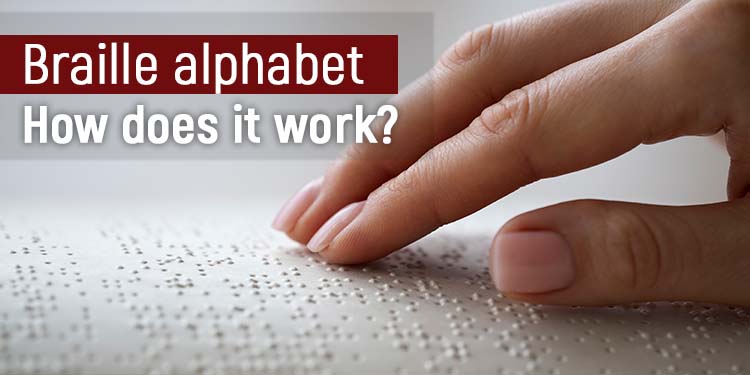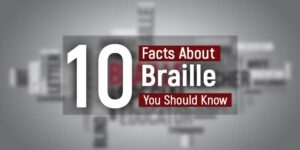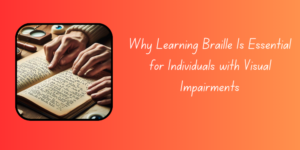In this world dominated by visual communication, braille stands as a sign of inclusivity. It allows all individuals with visual impairments to access written information independently. With some raised dots arranged in a specific pattern, braille is referred to as the tactile writing system that helps blind people read through their touch.
But there can be a common query among all about how the system of braille alphabets works and the intricacies behind decoding its dots. This blog will unveil it all. So, without further ado, let’s move to the main discussion.
Unveiling Braille Alphabets
The braille alphabet can be used by blind people or the visually impaired to form the base for the braille code that is used for writing and reading. Adults and children who are blind read braille by moving their fingers over the embossed braille dots. Blind people can also learn braille by touching or using their eyes. An excellent place for all to start learning braille is to use an alphabet for braille.
Learn Braille From Scratch
The first thing to remember is that braille is a type of code, not a language in itself. There are various “grades” and versions of braille. The simplest is “grade one braille,” in which each letter is transliterated. For each letter of the English alphabet, there are braille characters. The braille letters are composed of raised dots inside the cell of the braille. It is braille’s primary element of braille. Let’s begin with this.
The Braille Cell
The braille cell consists of six dots arranged in three columns and rows. Each dot has a unique number from 1 to 6. Starting in the upper left corner of the cell is dot 1. Moving down the column until the middle row is dot 2, dot 2. Then, in the lower left corner, dot 3. In the top right corner, there is dot 4, while the middle dot on the right column is dot 5. The corner in the bottom left is dot 6.
Braille Letters a – j
The braille alphabet follows an alphabetic pattern that is repeated throughout. The most simple alphabet to master is “a,” which is dot 1. The next letter is “b,” is dot 1 as well as dot 2, and “c” is dot 1 and dot 4. We’ve added the dot layouts to the table below to make it easier.
| Letter | Dots Configuration |
| a | 1 |
| b | 1, 2 |
| c | 1, 4 |
| d | 1, 4, 5 |
| e | 1, 5 |
| g | 1, 2, 4, 5 |
| h | 1, 2, 5 |
| i | 2, 4 |
| j | 2, 4, 5 |
Braille Letters k – t
The next set of letters follows the same pattern of adding a dot to each character of the braille’s first set of letters.
| Letter | Dots Configuration |
| k | 1, 3 |
| l | 1, 2, 3 |
| m | 1, 3, 4 |
| n | 1, 3, 4, 5 |
| o | 1, 3, 5 |
| p | 1, 2, 3, 4 |
| q | 1, 2, 3, 4, 5 |
| r | 1, 2, 3, 5 |
| s | 2, 3, 4 |
| t | 2, 3, 4, 5 |
Braille Letters u – z
The final set of letters follows the same pattern but adds a dot 6 to the second letter set. However, an exception is there that breaks the pattern. When Louis Braille invented the first braille alphabet, however, the French language did not have the”w” as a letter “w” so it was removed. Braille’s”w” letter “w” is instead created by dots 2, 4, 5, 6.
| Letter | Dots Configuration |
| u | 1, 3, 6 |
| v | 1, 2, 3, 6 |
| w | 1, 3, 4, 6 |
| x | 1, 3, 4, 5, 6 |
| y | 1, 3, 5, 6 |
| z | 2, 4, 5, 6 |
Capital Letters
They are all lowercase braille letters of the English alphabet. To create capital letters, putting an asterisk 6 before the letter is necessary. There are braille characters that can be used for other symbols and punctuation. There’s plenty to know about braille!
Other Ways to Make Use of Braille
You’re probably wondering about braille numbers, music in braille, and other languages available in braille. Braille numbers are similar to letters; however, they have a unique number symbol on the front of them to inform users that the characters they follow are designed as numbers. Some codes are specifically designed for math, and music in braille notation, as well as some languages, use their braille code.
Wrap It Up!
It’s time to wrap up. By understanding the structure and function of braille, we can properly appreciate its role in incorporating inclusivity and equal access to information for all. With Braille Music and More, you can explore the world of music and transcription services for visually impaired individuals. Take the next step towards accessibility, take the next step towards braille.
You Can Also Read Our Other Blogs
- Top 10 Fascinating Facts About Braille
- How to Translate Braille: A Comprehensive Guide
- 4 Ways Learning Braille Can Be Fun and Games
- Simplified Braille: Exploring Unified English Braille (UEB)
- The Importance of Braille in Today’s World
- The Impact of Braille Menus in Restaurants
- 12 Things You Probably Don’t Know About Braille
- Contracted (Grade 2) Braille Explained
- 12 Things You Probably Don’t Know About Braille
- How to Write in Braille







